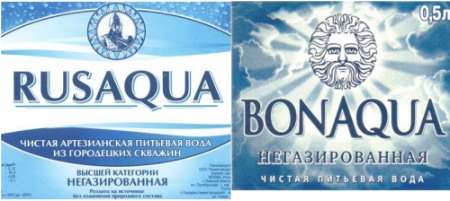Trademark patrol reveals another Coca Cola’s trademark infringement in Russia?

Companies like Coca-Cola, which values its brand name at $34 billion, take a very dim view of trademark infringement.
So I’d better say this in the very beginning of my post: “These materials are presented here for private educational, scholarly, and research uses”, OK?
While Russian bombers continue routine patrol missions over the Atlantic Ocean, we continue our routine trademark watch patrol missions over trademark applications recently filed with Russian Patent Office.
Yesterday, while sorting through our own database of Russian trademark applications, I came across a drawing which struck my mind as resembling something quite familiar…”wait, what was that?” I thought to myself… hmm, looks like a Coca-Cola’s BonAqua. To be certain, I retrieved all BonAqua marks from RUPTO database, and whoa!
Funny thing is, that RusAqua mark was filed the very next day after BonAqua sign got registered (but not the date it was published, so it’s a pure coincidence).
RusAqua
Filed 24/oct/2007 by company from Nizhny Novgorod (where Coca-Cola has one of the largest bottlers companies in Russia).
Bonaqua
Registered in Russia by Coca-Cola Company (US)
Priority date: 2004.10.25
Registration date: 2006.10.23
Published: 2006.12.12
So, the question is – is that RusAqua confusingly similar to BonAqua mark registered by Coca-Cola? We have to wait to see whether RusAqua makes it to Official Gazette (I’ll post update later), but anyways – what’s considered to be confusingly similar?
Coca-Cola is so big, it gets mentioned in all and every trademark infrigement case studies.
For instance, Crashcourse says following on regard of “Use for similar goods or services“:
The most common type of trademark infringement probably occurs when somebody else sells a product or service under a name that in some way resembles a registered trademark, and the products in question are the same or similar to the registered products.
The main criterion here is whether the name of the product is confusingly similar to the trademark. If they are, then potential buyers might accidentally buy the wrong product, and that is exactly the kind of situation that trademark law was designed to prevent.
Determining whether two things are confusingly similar is very complex. The label of the product in question must be compared to the trademark as a whole. Even if certain elements do correspond (for example the same type of graphical symbols are used, and the various elements are arranged in a similar way) the total impression might still be different. And it is the total impression that is important, because consumers will rarely pay attention to details when making a selection of a product.
Two products are considered similar if the public would be of the opinion that the services or goods in question are of the same company or of economically linked companies… Of course, the more famous a trademark becomes, the bigger the chance that the public’s opinion would change. The trademark Coca Cola for example appears on many different products, ranging from T-shirts to duvets. Given this information, the public would easily think that somebody selling pillows with the Coca Cola trademark on it had something to do with the Coca Cola company. Based on this, the trademark holder can act against such use of his trademark.
But even Coca-Cola itself cannot avoid trademark infrigement completely, the classic exmaple would it Coca-Cola Zero launch campaign. No, I’m not talking about famous viral video “Coke sues Coke Zero for Infringement”, although it’s pretty funny by itself (if you dont get it, this is a joke, Coke is owned by the same people who make Coke Zero. They wouldn’t sue themselves, even for such a funny thing as “taste infringement” might be 🙂
I’m talking about Zero – there was dispute over the Zero name. As mentioned in Wikipedia, in Norway the Brewery Ringnes claimed that Bryggeriforeningen owns the right to Zero name. The Zero name was used on a non alcoholic beverage from 1972 to 1996.
So despite of being one of the most expensive trademarks in the world and succesfully catching up with recent trends (like becoming Coca-Cola 2.0 and supposedly “releasing” their trademark for Second Life use), it cannot completely secure itself against trademark pirates popping up in third world countries like Russia 🙂 (but something tells me what Russia is not that much thrid-worldy anymore…My guess is what Russian market is one of the largest for Coca-Cola).
Coca-cola is yet to turn to our service, but they’d better not to wait too long 🙂
PS re copyright infringement and most expensive trademarks in the world… Wired recently blogged on quite a thought provoking theme “Is Copyright Infringement So Bad?” – “Where do we draw the line between artistic freedom and copyright infringement? As of now, and this is undeniable, those lines are drawn by legislators, and those legislators are paid by rich people, and copyright owners are rich.” Take a look at it.
Related posts:
Filed under: copyright infringement, registration of trade marks in Russia, trademark watch service



what is this topis ABOUTTT? Where do you the similarities between these logos? a?
not a single copied thing, different name, font, background, logo sign!
absolute useless topic. where the hell is world going, ah?
Come on, just click on the picture and give the bigger picture a better look 🙂